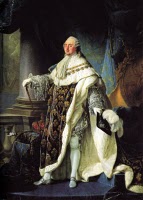National Assembly Pledges the Tennis Court Oath
 Wednesday, June 17, 2009 at 3:02PM Tweet
Wednesday, June 17, 2009 at 3:02PM Tweet So, as I was saying here…
On 17 June 1789, the Versailles convention delegates representing the Third Estate – that is, all French citizens who were not clergy, royalty, or nobility – broke from the monarchy of King Louis XVI for good. They declared themselves the true government of France. They named their government the National Assembly, an assembly not of the Estates, or classes, but of The People.
 They did this in the king’s own indoor tennis court where they were forced to convene after the king kicked them out of his meeting. And they swore, in the Tennis Court Oath of 20 June 1789, that they would not separate until they had written France's first constitution.
They did this in the king’s own indoor tennis court where they were forced to convene after the king kicked them out of his meeting. And they swore, in the Tennis Court Oath of 20 June 1789, that they would not separate until they had written France's first constitution.
Many members of the clergy and 47 members of the nobility left the King’s meeting to join the new National Assembly. Painter Jacques-Louis David was there, too. He immortalized this important turning point in French history in the celebrated painting, above.
Observe the three figures embracing in the center foreground. The subject in white is a member of the clergy; the man on the right, bending his knee, is a nobleman; and it's the Third Estate representative in the middle who unites them.
Of course, you do see who is missing from the image, no?***
Stay tuned: the march to 14 July continues...
Image:
Courtesy of Wikimedia Commons.
Source:
Towle, Sarah B. Time Traveler Paris Tours: Beware Madame La Guillotine, in development.






 On the south side of the river
On the south side of the river 
